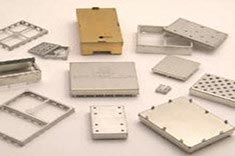EMI Shielding Products
- Custom Gasket Fabrication
- Connector Gaskets
- Bonded O Ring
- Custom Gaskets
- Conduct-O-Knit Knitted Wire Mesh
- Conduct-O-Seal Combo Gasket
- Conduct-O-Elastomer
- Conduct-O-Seal Oriented Wire in Silicone Gasket Material
- Conduct-O-Mesh Tape
- Conduct-O-Foam
- Conduct-O-Bond
- Optical Filters For Electronic Displays
- Shielded Vent Panels
- ESC Board Level Shielding
- 300 Series
Choosing the Right RF Shielding Materials for Corrosive Environments
 Electromagnetic interference (EMI) is an increasingly common concern for electronic enclosures. For those working in highly corrosive environments, shielding against radio frequency (RF) interference becomes even more complex. Corrosive settings such as marine environments, industrial facilities with high humidity, and coastal areas near saltwater all present unique risks that can compromise shielding materials over time. Often, it's not only the material's ability to block interference but also its resilience against corrosion that matters.
Electromagnetic interference (EMI) is an increasingly common concern for electronic enclosures. For those working in highly corrosive environments, shielding against radio frequency (RF) interference becomes even more complex. Corrosive settings such as marine environments, industrial facilities with high humidity, and coastal areas near saltwater all present unique risks that can compromise shielding materials over time. Often, it's not only the material's ability to block interference but also its resilience against corrosion that matters.
For engineers and designers tackling RF shielding in corrosive environments, selecting the right materials and protective finishes can deliver both RF attenuation and durability. A thoughtful approach to material choice can also prevent costly maintenance and equipment failure.
Understanding Material Susceptibility to Corrosion
The right shielding material must offer electrical conductivity for RF attenuation and chemical stability against corrosion. Corrosive damage typically arises from combining metal surfaces with environmental factors, such as moisture, salt, or chemical exposure. Some metals, like aluminum and magnesium, are particularly susceptible to galvanic corrosion, especially when paired with dissimilar metals in wet or salt-heavy environments. This reaction can degrade both conductivity and structural integrity. Materials like nickel and Monel—known for their corrosion resistance—are often recommended to minimize this risk.
- Nickel provides excellent resistance to oxidation, which helps maintain conductivity even in harsh conditions.
- Monel, a nickel-copper alloy, also resists corrosion well, though it can be reactive when in contact with certain other metals like aluminum in electrolytic conditions.
Using Protective Coatings to Extend Material Longevity
Protective coatings play a critical role in enhancing corrosion resistance for RF shielding materials, particularly in environments where direct exposure to corrosive agents is unavoidable. Conductive coatings like the CHO-SHIELD 2000 series provide an effective barrier that shields against RF interference and protects the base metal from corrosion. These coatings are beneficial for aluminum surfaces, which are prone to rapid corrosion in high-salinity or humid conditions. To maximize effectiveness, coating thickness and curing methods are crucial:
- A 4-5 mil thickness is generally required for conductive coatings to provide the necessary corrosion resistance.
- High-temperature curing (around 250°F) yields superior corrosion protection compared to room-temperature curing, which can result in lower durability over time.
Selecting Metal Combinations for Corrosive Environments
In corrosive settings, selecting compatible metal combinations for RF shielding is essential to avoid galvanic corrosion, which can occur when two dissimilar metals contact each other in the presence of an electrolyte, like saltwater. To mitigate this, materials are often grouped based on galvanic compatibility. When using materials from different groups, a protective coating is typically applied to the more reactive material to prevent accelerated corrosion at the interface. Some general guidelines include:
- Nickel-Plated Materials: For high-resistance metals, nickel plating on aluminum surfaces can prevent galvanic corrosion.
- Monel in Marine Environments: Monel offers excellent shielding properties and corrosion resistance. It's ideal for marine or salt-rich environments, though it should not be paired directly with aluminum.
- Silver-Plated Aluminum Elastomers: In settings where a strong seal is needed, silver-plated aluminum elastomers show lower corrosion rates than other options, maintaining conductivity with minimal degradation.
Practical Design Tips for Corrosion Control
- Minimize Gaps and Exposed Edges: Corrosive damage often begins at exposed edges and gaps in the shielding material. A moisture-sealing EMI gasket with compression properties suited to the environment can limit exposure and inhibit corrosion.
- Seal with Dual EMI Gaskets: In environments with extreme exposure, dual gaskets—one conductive, one non-conductive—can help create a barrier, reducing corrosion while maintaining conductivity.
- Apply Edge Sealing for Added Protection: In applications like aircraft or coastal installations, a sealed EMI gasket edge, particularly with conductive coatings, provides additional protection against environmental stressors.
Ensure Long-Term RF Shielding Success
Selecting RF shielding materials for corrosive environments requires balancing attenuation needs with long-term durability. Material choices, protective coatings, and design techniques can all impact the shielding's effectiveness and lifespan. Engineers can create RF shields that withstand environmental challenges without compromising performance by prioritizing corrosion-resistant metals, ensuring galvanic compatibility, and applying proven coatings.
For those working in challenging settings, investing in the right materials and design methods is about more than preventing interference—it's about preserving functionality and safety in corrosive elements.



